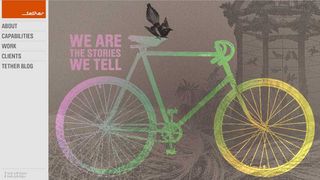Why design is like acting – and how you can improve your pitches
Designer Stanley Hainsworth reveals what all creatives can learn from the world's best actors.
Stanley Hainsworth is the CCO of creative agency Tether. He blogs about everything from brand storytelling to the transference of time, and spoke at this year's Design Indaba. Here, he explains why design is like acting…
The job of an actor is to look at life, discern the way people behave and reflect that behaviour in the most genuine possible way so that the audience will believe in and empathise with the character.
But if affectation seeps in or even the slightest glimmer of pretence is revealed, the delivery falls flat and the character's integrity is irreparably broken.
I like to compare this to the job of a designer tasked with creating a branding campaign: you're trying to design something with passion that people will care about, but if you don't truly believe in the concept or the client, then neither will your intended audience.
Making emotional connections
Of course, when you're acting it's also about creating that emotional connection with the other characters on stage. In this sense observation is as important as delivery.
But when you're up on stage auditioning for a role, it's essentially the same as pitching a design concept or presenting your work. Both require an embodied, affective relation to the material – the script or the design rationale – in order to be convincing to the audience or the client.
What's important in these situations is not to take things personally. Presenting a design idea is not the same as presenting yourself, just as playing a part in a play says nothing about an actor's personality.
Yet this is a trap that some designers, and especially young designers, fall into. Like the actor, the designer must learn to handle rejection, otherwise they will quickly lose confidence in their art.

One important lesson I learned early on in my design career is the importance of having confidence in your presentation material. For example, some designers employ a method called 'bracketing' – rather than pitching one idea, they pitch three: something conservative, something in the middle and something way out there. They present them to the client hoping they will choose the middle-ground.
I did that once and the internal client I was presenting to chose the conservative one. "No, no, no, not that one!" I said. Her reply was something I'll never forget: "Well, why did you ever show it to me then?"
Learning lessons
The lesson was clear. Never show anything you can't stand behind and support wholeheartedly. To do otherwise risks tarnishing the relationship between the designer and the client, which might be compared to the dynamic between actors on stage.
A certain chemistry should exist between two actors that reflects a level of give and take. You can always tell when an actor can't wait to jump in and say their lines and they are not listening to what you are saying – they just stare blankly and then when you are finished they deliver their line.
I've worked with designers who make a point of waiting a moment after the client has stopped talking in order to register their understanding of what has been said. Design is a conversation, so never stop listening.
Words: Stanley Hainsworth
Illustration: Zaneta Antosik
This article first appeared inside issue 239 of Computer Arts, the world's best-selling creative design magazine. Save up to 59 per cent with a subscription to Computer Arts.
Liked this? Try these...
- How to bloop your way to design success
- Why designers should lecture more often
- The best free cursive fonts

Thank you for reading 5 articles this month* Join now for unlimited access
Enjoy your first month for just £1 / $1 / €1
*Read 5 free articles per month without a subscription

Join now for unlimited access
Try first month for just £1 / $1 / €1
Get the Creative Bloq Newsletter
Daily design news, reviews, how-tos and more, as picked by the editors.
The Creative Bloq team is made up of a group of design fans, and has changed and evolved since Creative Bloq began back in 2012. The current website team consists of eight full-time members of staff: Editor Georgia Coggan, Deputy Editor Rosie Hilder, Ecommerce Editor Beren Neale, Senior News Editor Daniel Piper, Editor, Digital Art and 3D Ian Dean, Tech Reviews Editor Erlingur Einarsson, Ecommerce Writer Beth Nicholls and Staff Writer Natalie Fear, as well as a roster of freelancers from around the world. The ImagineFX magazine team also pitch in, ensuring that content from leading digital art publication ImagineFX is represented on Creative Bloq.
